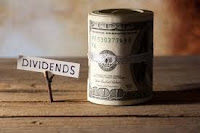"Avoiding serious loss is a
precondition for sustaining a high compound rate of growth." -- Roger Lowenstein, Financial Journalist and Director,
Sequoia Fund
Dividend Farming
is an investing practice extended into a future horizon. It’s not a “get rich quick” activity doubling
your money in six months, a year, or even two.
It relies upon the reinvestment of dividends to compound growth and that
requires time.
If Dividend Farming investments are compounding at 4%
annually, how do we expect them to perform better than alternatives that may be
enjoying double-digit growth today? How
can I believe that a lowly 4% return will get me where I want to be in 20 or 30
years? Answering that question means investigating
two scenarios. The first involves a steady-eddy
dividend play while the second is a high-flying investment that is volatile over
time.
Both examples start with a single share of stock priced at
$50. Each share is held for 20 years.
The stock paying a dividend offers a steady, 4% annual
dividend.
The alternative offers no dividend, but a cyclical trajectory
of increases and decreases during the 20-year period. Within that timeframe the stock enjoys two
years of 30% growth, two years in which it declined 30%, two years of zero
growth, and the balance at 7% growth which is the historical market average.
|
Year 0
|
$
50.00
|
Annual Growth
Dividend Stock
|
$
50.00
|
Annual Growth Non-Dividend Stock
|
|
1
|
$
52.00
|
4%
|
$
53.50
|
7%
|
|
2
|
$
54.08
|
4%
|
$
69.55
|
30%
|
|
3
|
$
56.24
|
4%
|
$
74.42
|
7%
|
|
4
|
$
58.49
|
4%
|
$
79.63
|
7%
|
|
5
|
$
60.83
|
4%
|
$
85.20
|
7%
|
|
6
|
$
63.27
|
4%
|
$
59.64
|
-30%
|
|
7
|
$
65.80
|
4%
|
$
63.82
|
7%
|
|
8
|
$
68.43
|
4%
|
$
68.28
|
7%
|
|
9
|
$
71.17
|
4%
|
$
73.06
|
7%
|
|
10
|
$
74.01
|
4%
|
$
94.98
|
30%
|
|
11
|
$
76.97
|
4%
|
$ 101.63
|
7%
|
|
12
|
$
80.05
|
4%
|
$ 101.63
|
0%
|
|
13
|
$
83.25
|
4%
|
$ 108.74
|
7%
|
|
14
|
$
86.58
|
4%
|
$ 116.36
|
7%
|
|
15
|
$
90.05
|
4%
|
$
81.45
|
-30%
|
|
16
|
$
93.65
|
4%
|
$
87.15
|
7%
|
|
17
|
$
97.40
|
4%
|
$
93.25
|
7%
|
|
18
|
$ 101.29
|
4%
|
$
93.25
|
0%
|
|
19
|
$ 105.34
|
4%
|
$
99.78
|
7%
|
|
20
|
$ 109.56
|
4%
|
$ 106.76
|
7%
|
|
Advantage
|
3%
|
At the end of the 20-year holding period, the dividend
paying steady-eddy outperformed the volatile non-dividend payer by 3%.
This is a hypothetical exercise; the kind of which academics
are fond. It’s clean, clear, and
unencumbered by things like the real world.
Although neither stock is guaranteed to grow exactly as shown, the
exercise is helpful in four ways.
 |
| Dividends Roll Up Over Time |
First: It shows what can happen when a dividend
payer with a long history of payments, that is likely to continue, can do. Moreover, it does so with better forecast
accuracy. Investing in a dividend
champion helps reduce your risk. Firms
with growth and decline that cycle unexpectedly and abruptly are difficult to
count upon to deliver the returns you need over time.
Second: The consistent progression of the dividend
payer also means that if you need to take money from your investment you’re
less likely to do so at a significant low point in the market. Investments that swing up and down like that
of the alternative mean you could be forced to take a distribution during a
market decline. If that happens you may
not be able to make up the loss, particularly if your investing horizon is
short.
Third: The average yield during the period for
the first investment is 4%. However, the
average yield for the second investment is 5%, yet comes up short. The reason is that the compounding effect is
diluted by the years of large losses.
This is the essence of Lowenstein’s quote above. If you don’t understand how this can happen,
consider
this example.
Fourth: 3% outperformance is a win. Better performance with less risk is what
margin of safety is all about. It may
not be glamorous, but who cares? You
still win. See a couple of the dividend
articles linked here
for more about the performance of dividend stocks over time.
Getting to your horizon with the money you need, sleeping
soundly along the way, is the essence of Dividend Farming.
The thoughts and opinions
expressed here are those of the author, who is not a financial
professional. Opinions expressed here should not be considered investment
advice. They are presented for discussion and entertainment purposes
only. For specific investment advice or assistance, please contact a
registered investment advisor, licensed broker, or other financial
professional.
No comments:
Post a Comment